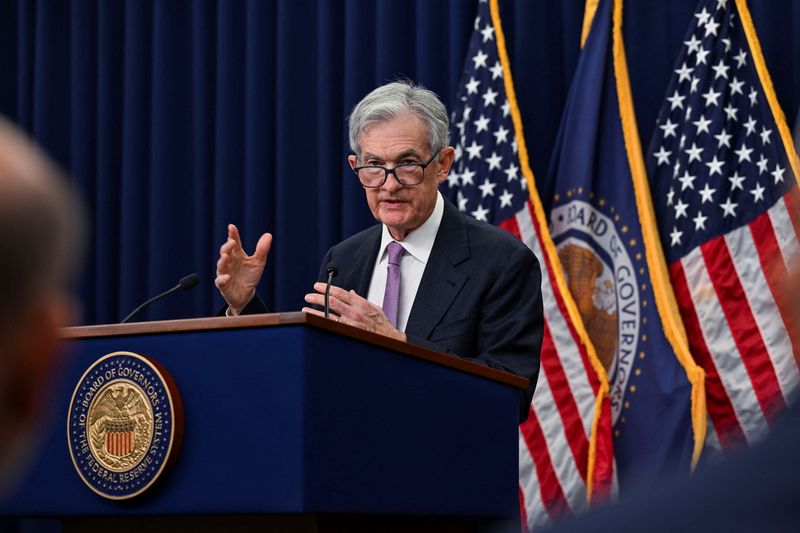By Jamie McGeever
ORLANDO, Florida (Reuters) - If bond investors take away one lesson from the last few years, it's this: pay attention not so much to what Jerome Powell says, but what he does.
If not, they should strap themselves in for a rocky ride, as they're likely to continue pricing in the loose policy of Powell's speeches, only to be pulled back in line by the reality of his actions.
The Federal Reserve Chair struck a relatively dovish tone in his press conference yet again on Thursday after the central bank cut interest rates for a second consecutive meeting, this time by an expected quarter percentage point.
This surprised some Fed watchers, given the dramatic upward shift in bond yields since the Fed's last meeting and the tectonic political shift that took place in Washington this week.
The 10-year Treasury yield had soared as much as 80 basis points since the Fed cut rates by 50 basis points on Sept. 18, sparking some concern that the Fed could lose control over the long end of the curve. It rose 14 bps alone on Wednesday after Donald Trump's resounding U.S. presidential election victory.
One school of thought held that, against this backdrop, Powell would seek to anchor the long end of the curve by talking tough, perhaps by flagging a pause in the easing cycle, nodding to a higher terminal rate, or committing to continued balance sheet reduction.
But that is not the path he chose.
True, he acknowledged that the U.S. economy may be stronger next year than previously anticipated and that inflation may take a while to get back to target. And he stressed that the Fed remains data-dependent.
But his message fell on the dovish side of the fence.
NATURAL TENDENCY
This shouldn't have surprised anyone. Dovishness has been Powell's default position for years, regardless of what the central bank has ultimately done. While Powell's actions reflect the Federal Open Market Committee's central policy stance, his words make him one of its most dovish members, according to a JP Morgan natural language processing model.
This divergence is likely one reason why investors have repeatedly priced in more monetary easing than has materialized in the last couple of years.
Since the final rate hike of the Fed's tightening cycle in July last year, the central bank has held 10 policy meetings. While the initial rate cut of this cycle didn't come until this September, Powell struck a broadly dovish tone in his post-decision press conferences over that entire period.
And the bond market seemed to take him at his word. The 10-year yield fell on eight of those days, by an average of nearly six basis points, and rose only twice. And zooming out to the Wednesday-Friday period following an FOMC press conference, the 10-year yield declined after six of the past nine meetings, by an average of 17 basis points.
Of course, many factors influence bond prices on any given day, but the patterns here suggest that, unsurprisingly, a huge one is the language of the person in charge of setting monetary policy.
MIXED MESSAGES
This doesn't mean Powell's actions have never skewed dovish. Just look at the 50 bps cut in September. And, to be sure, if the Fed needs to ease policy substantially, it will.
But given the action in the bond market, it's becoming increasingly likely that Powell's Fed may need to adopt a 'go slow' approach in this cycle, meaning it keeps rates relatively high. Tuesday's election makes this more likely, as Trump's fiscal policy agenda is likely to widen the already significant budget deficit even further and fuel inflation, in an economy where growth is humming along nicely at just under 3%.
So why did Powell pull out the dovish script yet again on Thursday?
Maybe he felt that he had to counter the recent bond selloff. Goldman Sachs's U.S. financial conditions index is up around 30 basis points since the Sept. 18 rate cut, and 30-year fixed mortgage rates have spiked around 70 basis points to a four-month peak of 6.79%.
Or maybe he is truly concerned about cracks in the labor market. Or perhaps this is just what he always does.

But, regardless, investors should keep in mind that even if the Fed ultimately steers a less accommodative course, the captain of the ship will likely continue signaling a different turn.
(The opinions expressed here are those of the author, a columnist for Reuters.)
(By Jamie McGeever; Editing by Chizu Nomiyama)